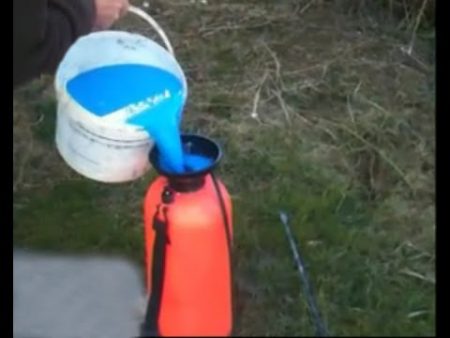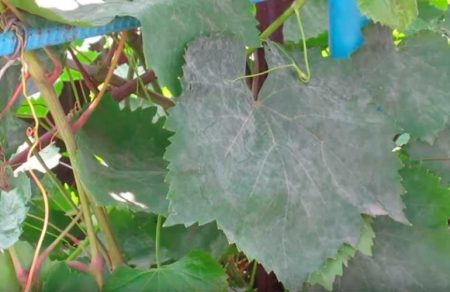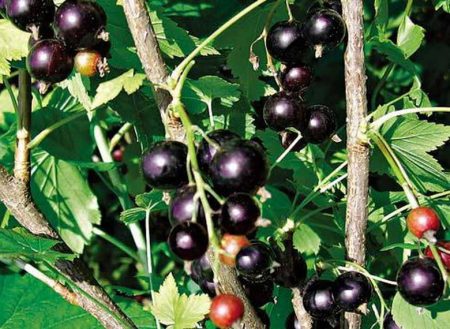Powdery mildew is a plant disease caused by powdery mildew fungi. There are about 500 species of powdery mildew pathogens, many of which affect 1-2 host plant species.
Description of the pathogen
The causative agent of powdery mildew on black currants and gooseberries is the pathogenic fungus Sphaerotheca mors uvae.Its other name is ash grass; in the scientific literature, the disease caused by it is called American powdery mildew. The pathogen of this particular species came from America to Europe with seedlings, hence its scientific name. This fungus belongs to a different species than those that cause disease on cucumbers, apple trees, rose hips and other gardening and ornamental crops. Therefore, drugs successfully used to control powdery mildew on other crops may be useless for this type of pathogen.
The pathogen overwinters in the soil and on affected plant debris. The spread of ashtrays is facilitated by:
- wet weather and high humidity;
- significant fluctuations in air temperature;
- thickening of currant bushes;
- high planting density of bushes, which increases the rate of spread of powdery mildew and complicates preventive and control measures;
- growing varieties susceptible to powdery mildew;
- use of high doses of nitrogen fertilizers.
The fungus reproduces by patches of mycelium and spores that ripen at the end of summer.
Conditions for the development and spread of powdery mildew
The fungus actively develops at a temperature of 18-28°C. At temperatures above 28°C, the parasite stops developing, signs of the disease do not increase, but the pathogen itself does not die. When favorable weather arrives, it becomes active again, and the picture of the lesion is fully revealed. At temperatures below 16°C, mycelial growth slows down, and below 7°C it stops completely.
The parasite is very widespread, the disease can occur throughout the growing season, but most often currants are affected from mid-June to mid-August.Disease spores are carried by wind, water, animals, with garden tools and on the clothes of the summer resident.
Signs of currant disease
Affects black currant and gooseberry berries. The vast majority of red and white currant varieties are resistant to powdery mildew, but there are still some old varieties that are susceptible to the disease; On such varieties, powdery mildew develops only on the leaves.
The disease primarily affects young currant leaves growing on the tips of the shoots, then spreads to berries and old leaves.
First, a white cobwebby coating appears on the affected parts, which is very easy to wipe off. But the mycelium has already penetrated the plant tissue and begun its destructive effect, so the plaque appears again and again, quickly grows and spreads to neighboring leaves and berries.
As it grows on them, it covers most of them, and the affected areas look as if they have been sprinkled with flour.
After a few days, the mycelium thickens, becomes felt-like, and black dots appear on it - fungal spores. When these dots burst and the spores disperse, droplets of liquid resembling dew drops are left on the felt.
The berries gradually become covered with felt and dry out. They cannot be eaten as food; the harvest is completely lost. Young leaves stop growing, turn brown and dry out. The shoots become bare, deformed and do not grow. The annual growth does not ripen in cold weather and freezes in winter. The disease greatly reduces the winter hardiness of currants in general.
If you do not fight the disease, powdery mildew will appear the next year, and in 2-3 years it will completely destroy all blackcurrant plantings.
Measures to combat powdery mildew
It is impossible to completely destroy powdery mildew. It will appear again and again on currant bushes that are susceptible to the pathogen. Therefore, on such bushes it is necessary to take annual measures to prevent and eradicate the disease.
To combat powdery mildew on black currants use:
- sulfur preparations;
- preparations containing copper;
- systemic fungicides.
Sulfur and its derivatives. The drugs are low-toxic, they can be used during currant budding, during berry filling and 2-5 days before harvest. The main condition for their use is that the temperature should not be lower than 20°C. At lower temperatures, the effectiveness of the drugs is significantly reduced. If the temperature exceeds 35°C, then currants cannot be treated with sulfur preparations, since under such conditions sulfur becomes toxic and causes burns and leaf fall on the bushes, although the spheroteca also dies.
To treat American powdery mildew, use: Thiovit Jet, colloidal sulfur.
Copper-containing drugs. For the treatment of spheroteca, they are somewhat less effective than sulfur and are classified as contact fungicides. To combat dew, currants are sprayed 3 times. The drugs are changed with each subsequent treatment, since the fungus very quickly becomes resistant to them and 2-time treatment with the same drug will be ineffective.
Treatment with preparations containing copper sulfate (Bordeaux mixture, copper sulfate) is done only for preventive purposes. The active substance protects bushes from infection for 2 weeks. But they are unsuitable for combating the disease, since the pathogen is highly resistant to copper sulfate.
Ordan and HOM, which contain copper oxychloride, are suitable for combating spheroteca. But they are most effective only at the very beginning of the development of the disease.
Copper preparations can be alternated with iron sulfate. It is very effective in combating American powdery mildew at the onset of the disease, when cobwebs have just appeared.
The main reason for the low effectiveness of contact fungicides is that they do not penetrate the affected currant tissue where the mycelium is located, but act only on the surface.
Systemic fungicides effective both as a preventive measure and for treating the disease. These include
- Skor and Rayok (they have the same active ingredient)
- Tilt
- Topaz
- Topsin-M.
After contact with the leaves, they enter the plant tissue within an hour. On the affected parts they destroy the mycelium, destroy germinating spores, and prevent the development of the fungus. Destroy infection inside and on the surface. Systemic fungicides accumulate in fruits, so treatment with them is possible only 15-28 days before harvest.
To effectively combat the disease, systemic fungicides must be alternated, since spheroteca quickly acquires resistance to them. The best option is to alternate them with contact fungicides, but systemic and contact fungicides cannot be combined.
Regardless of what preparations are used, the leaves are sprayed from both the upper and lower sides. Be sure to water the ground around the currant bushes with the same solutions. Spraying alone without soil disinfection will not help get rid of spheroteca; the disease will appear again and again as long as the pathogen remains in the soil.
Folk remedies for combating American powdery mildew
All folk remedies have a mainly preventive effect. Powdery mildew is a very persistent and very stubborn disease and is difficult to get rid of. With the slightest delay in taking radical measures, it can spread widely.
Of the folk remedies, the following are the most effective.
- Kefir or whey. 1 liter of product is diluted in 10 liters of water, soap is added for better adhesion. Spray currant leaves from the top and bottom sides. This is a fairly effective control measure, since lactic acid bacteria are competitors of powdery mildew and prevent their development.
- Iodine solution. 10 ml of 5% iodine is dissolved in 10 liters of water and sprayed onto the currants. Iodine creates an acidic environment in which it is difficult for the fungus to survive, and alcohol disinfects the leaves, kills spores and prevents the penetration of the mycelium into the tissues of leaves and berries.
- Dissolve 0.5 g of potassium permanganate in 5 liters of water. The result is a very concentrated solution, which is used to spray the bush. Potassium permanganate is one of the best disinfectants.
- 100 g of onion peels are poured into 3 liters of boiling water and left for 2 days. Then filter, dilute the resulting concentrate in 10 liters and spray the currants. Onions contain phytoncides that prevent the germination of pathogen spores.
- 200 g of wood ash are poured into 2 liters of water, boiled for 20 minutes, left for 48 hours. The resulting concentrate is filtered, the volume is adjusted to 10 liters and the leaves are sprayed on both sides.
Since currant leaves are poorly wetted and the solution drains from them, soap is added to the working solution to better retain it.
If, despite all the measures, powdery mildew still appears on currants, then they immediately move on to chemical means of control.
Preventive measures
When used wisely, preventive measures are no less effective than fungicide treatment.
- Growing currant varieties resistant to American powdery mildew. Currently, quite a lot of them have been bred: Agata, Lazy, Zhuravushka, Perun, Chebarkul, Binar, Amur Cannery, Belarusian Sweet, Globus, Charm.
- Treatment of currants with the biological product Fitosporin. Spray and water the soil around the bushes.
- Reducing doses of nitrogen fertilizers, since their high concentration in the soil significantly reduces the resistance of currants to powdery mildew.
- Collect and immediately burn all affected leaves and berries.
Controlling powdery mildew on currants is not an easy task. You should always resort to comprehensive measures; this is the only way to, if not get rid of, then significantly reduce the spread of spheroteca in the garden.







 (5 ratings, average: 4,00 out of 5)
(5 ratings, average: 4,00 out of 5) CUCUMBERS NEVER GET SICK, I'VE BEEN USING ONLY THIS FOR 40 YEARS! I SHARE A SECRET WITH YOU, CUCUMBERS ARE LIKE THE PICTURE!
CUCUMBERS NEVER GET SICK, I'VE BEEN USING ONLY THIS FOR 40 YEARS! I SHARE A SECRET WITH YOU, CUCUMBERS ARE LIKE THE PICTURE! You can dig a bucket of potatoes from each bush. Do you think these are fairy tales? Watch the video
You can dig a bucket of potatoes from each bush. Do you think these are fairy tales? Watch the video
 How our fellow gardeners work in Korea. There is a lot to learn and just fun to watch.
How our fellow gardeners work in Korea. There is a lot to learn and just fun to watch. Eye trainer.The author claims that with daily viewing, vision is restored. They don't charge money for views.
Eye trainer.The author claims that with daily viewing, vision is restored. They don't charge money for views. A 3-ingredient cake recipe in 30 minutes is better than Napoleon. Simple and very tasty.
A 3-ingredient cake recipe in 30 minutes is better than Napoleon. Simple and very tasty. Therapeutic exercises for cervical osteochondrosis. A complete set of exercises.
Therapeutic exercises for cervical osteochondrosis. A complete set of exercises. Which indoor plants match your zodiac sign?
Which indoor plants match your zodiac sign? What about them? Excursion to German dachas.
What about them? Excursion to German dachas.